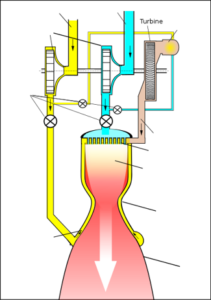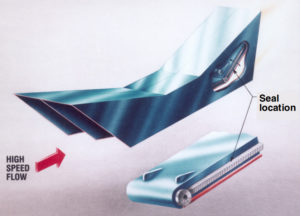
However, finding the optimum sealing solution that provides highly dependable performance can be formidable for several reasons, including extreme pressures and temperatures, chemical compatibility, SWaP, and outgassing, not to mention vendor requirements involving seal size manufacturing.
Extreme Pressures
Depending on the applications, the pressures faced by seals can involve not only high pressures in the range of 100 bar but ultra-high vacuum conditions as well. For example, consider a typical hypergolic rocket propulsion system where pressures can reach between 1,500 and 16,000 psi during Stage 2. To further complicate matters, pressure fluctuations make it much more challenging to retain a reliable seal.
Extreme Temperatures
One of the challenges involved in designing seals for propulsion systems often involves wide temperature ranges from cryogenic to extreme heat. For example, the fuel tanks on many modern rockets must provide sealing at cryogenic level temperatures at which many polymeric and elastomeric materials become brittle and unreliable. And when temperatures fluctuate, traditional seal solutions can experience significant dimensional changes, leading to leaks.
Material Compatibility
Seals for vehicle propulsion systems must be compatible with the fuels involved. For example, cryogenic hyperbolic bipropellants often require seals resistant to oxidizers. Also, keep in mind that, according to a NASA Lesson Learned on Static Cryogenic Seals for Launch Vehicle Applications, seal materials must also be compatible with any anticipated purge or cleaning material that they may come into contact with.
SWaP
SWaP (Size, Weight, and Power) is a significant factor in both space vehicle engineering and aerospace in general. Designs must fall within tight constraints for weight to minimize fuel requirements and size to reduce the overall volume of the space vehicle. In addition, seals, including those for the propulsion systems, must also be optimized to meet SWaP requirements.
Outgassing
Vacuum conditions make outgassing, the release of gasses from solid materials, a serious problem. This phenomenon not only introduces new chemicals to what may already be a volatile environment but can also lead to the deposition of chemicals on critical surfaces. Therefore, NASA makes available spacecraft material outgassing data to aid in selecting safe materials.
Size
Large fuel tanks necessitate large seals. For example, some of the seals for NASA’s SLS (Space Launch System) are over 6’ in diameter, and other fuel tanks have similar requirements. Such seals are challenging to both manufacture and test. Such large seals must usually be custom manufactured with small production runs, making it difficult to balance cost and performance. In addition, not all seal vendors have the manufacturing capabilities required for creating seals of this size at the proper levels of accuracy and precision.
Spring-Energized Seals

Image from NASA
Spring-energized seals, widely used in aerospace, are a practical solution for space vehicle propulsion systems. They can retain seal integrity even when subject to extreme pressure and temperatures due to the energizer. In addition, these seals can account for misalignment, eccentricity, thermal expansion and contraction, wear issues, and other dimensional changes. And they provide a consistent force over a wide deformation range.
The most commonly used materials for spring-energized seals in space environments include PTFE, FFKM, and Hytrel. However, when outgassing is a concern, materials such as PEEK, PAI, PI, Acetal, PCTFE, and antistatic PTFE can be considered. And many of these materials are also available with fillers to enhance their properties.
There are also a variety of choices regarding the spring energizer used. For example, cryogenic and vacuum pressure environments most often implement V ribbon springs (also known as V-springs), helical springs work exceptionally well for static cryogenic applications, and high-pressure conditions usually employ coil seals. And remember that canted coil springs can be highly customized to produce consistent forces.
Advanced EMC: Your Source for Space Vehicle Seals
When it comes to vendor concerns, Advanced EMC has the equipment and experience required to manufacture large seals accurately. Our sealing solutions team has the knowledge and understanding needed to help you at every step of selecting propulsion system seals for everything from small LEO satellites to passenger-laden space vehicles. Contact us today!

